|
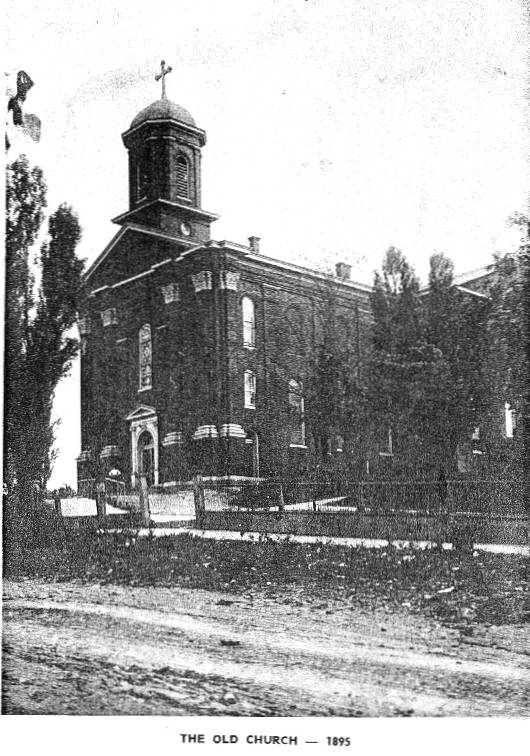
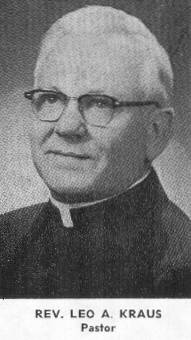
To the members, present and past, of St. Joseph Parish,
On an occasion such as this our hearts are filled with
gratitude-first of all to Almighty God from whom all good things come and then to the good people and priests who were instruments
of God in carrying on His work in this section of His vineyard.
The people who founded St. Joseph Parish and those
who continued it were never burdened with a superfluity of worldly goods. However they were always willing and ready to share
what they had in talents and money to take care of the needs of the parish. In this, they and the parish were blessed.
Today as we look back over the first one hundred years of the parish we marvel at what has been accomplished in a material
way and we feel confident that this material success is paltry in comparison to the spiritual good that has been accomplished
for its members and the community.
May the example and labors of our ancestors at St. Joseph's-your parents and
grand-parents-be a source of inspiration and encouragement to us as we carry the mission of the parish into the second century.
Sincerely Yours in Christ,
Rev. Leo A. Kraus
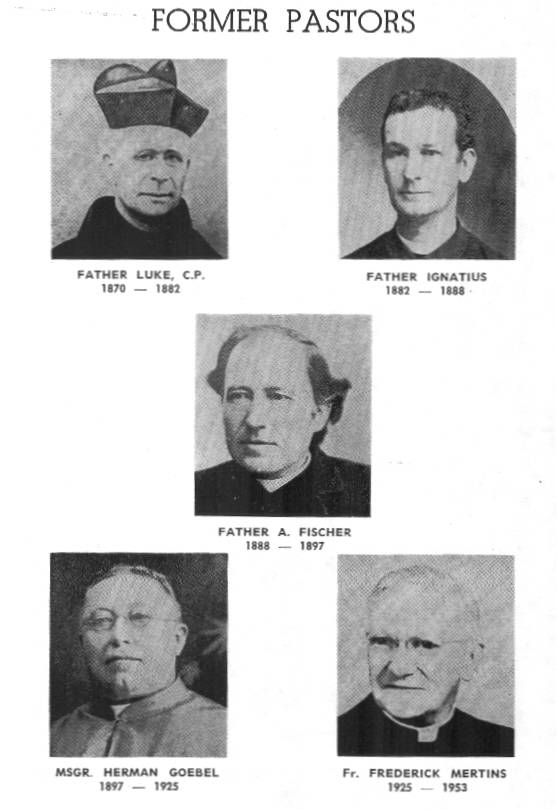

THE HISTORY
Shortly before the Civil War, a number of Catholic families migrated from Germany and settled
in what is now the Borough of Mount Oliver and part of the Sixteenth Ward of the City of Pittsburgh. The closest Catholic
Church was that of St. Michael on Pius Street. Fortunately, St. Michael's was a German parish and the early settlers affiliated
with it. The Passionist Fathers at St. Michael's took good care of the spiritual needs of the families, but, because of the
distance, the hilly terrain, the unimproved roads and lack of public transportation the families seriously handicapped in
their desire to take advantage of many spiritual opportunities offered by membership in St. Michael's parish.
A far-sighted member of the community purchased three quarters of an acre of ground, a mound in the midst of the settlement,
with the hope that eventually a church would be built there and a new parish founded. From the outset it was evident that
the project could not be undertaken immediately. The families were of very limited means. Some worked small farms; the majority
worked in the mines.
When the Civil War broke out and Pittsburgh was thought to be in danger of attack, a fort
was built on the mound chosen for the Church. The Fort was known as Fort Jones. The site was a natural one for the fort.
The highest point in the district, it commanded the territory for miles around. After the war the fort was abandoned and
thought was given again to the building of a church.
Even though the building of a church and the establishment
of a new parish had to be postponed, the people desired to see to it that their religion and national culture would be handed
on to their children. In 1860 the Pastor of St. Michael's, Father Luke Baudinelli, C,O., established a mission school in
a building standing at the corner of Ormsby Avenue and Ottillia Street. Classes were conducted by the lay teachers under
the supervision of Father Luke. The school had an enrollment of about one hundred children. The morning classes were taught
in German; the afternoon classes in English.
By 1868 the Passionist Fathers thought the time opportune for building and establishing a new parish. On July 12, 1868 Father
Luke called a meeting of the people from the hill and proposed the building of a church in their midst. They viewed the site
previously purchased and it pleased them. They decided at once to build. Plans were drawn and a contract for building was
let to Mr. Landelin Benz. On October 4, 1868 the corner stone was laid and blessed by the Most Reverend M. Domenec, C.M.,
the Bishop of Pittsburgh. In the fall of 1870 the building was completed and on November 20, 1870 Bishop Domenec blessed
it with solemn services. The parish was placed under the protection of St. Joseph, the chaste spouse of the Mother of god,
with the Passionist Fathers in charge. Father Luke Baudenelli, C.P. who from the beginning showed a deep interest in the
district and its people and who masterminded the financing and building of the Church was appointed its first Pastor. At
its birth the parish numbered 400 families and during its first year had 121 baptisms, 14 marriages and 42 deaths.
In 1881 Father Luke built the first parish school building. It consisted of four classrooms and a spacious hall. The
building still stands and with the later addition of a stage is our present Auditorium Building. Father Luke staffed the
school with Sisters of St. Francis from their Mother House on Pius Street.
In 1882 Father Luke was succeeded by
Father Ignatius Sauer, C.P.. During the pastorate of Father Ignatius the nucleus of a convent was erected giving the Sisters
their first permanent abode in the parish.
In 1888 the Passionist Fathers relinquished their charge of St. Joseph
Parish. they had brought it into being, nursed it through infancy and watched over it with loving care during its childhood.
Now that it had passed strong and healthy through adolescence they turned it over to the administration of the Diocesan clergy.
the parish had a beautiful church, a school, and a convent. It lacked a pastoral residence. During their tenure at St.
Joseph the Passionist Fathers in charge lived in a room over the boys' sacristy. The people of St. Joseph have not forgotten
nor will they ever forget what the Passionist Fathers have done for them.
Father Anthony Fischer was appointed
the first Diocesan Pastor of St. Joseph Parish. His first task was to build a pastoral residence. This he did in 1888-89.
That rectory still stands and is still in use as the parish rectory. In September 1889 Father Fischer purchased 21 acres
of land along Brownsville Road and converted it into a parish cemetery. In 1894 Father built a four room addition to the
school. Additional rooms meant additional teachers and additional teachers meant an addition to the convent.
In 1895 the parish celebrated its Silver Jubilee. Father Fischer had the church renovated and installed new altars and a
new organ. In 1896 under Father Fischer's guidance the Boiler House was built and the parish had a central heating plant.
Father Fischer's energetic and progressive administration was brought to an abrupt end when Almighty God called
him quite unexpectedly to and early reward. He was but forty-nine years old at the time of his death, October 3, 1897.
Father Herman J. Goebel, later Monsignor Goebel, succeeded Father Fischer. The parish continued its growth during his
tenure of office. When Father Goebel entered upon his pastorate the school consisted of six rooms with 300 children. At
his death it consisted of seventeen rooms with 925 pupils. In 1901 to keep pace with the demand for higher training Father
added a two-year commercial course to the school.
By 1905 the school population had outgrown its eight classrooms.
The four room school building erected during Father Fischer's administration was moved to its present location on Cathedral
Avenue and on its former site the present ten room Grade School was build. In 1911 a second addition was added to the convent
to take care of the Sisters needed for the rapidly growing school.
About this time Monsignor Goebel added a stage
and balcony to the hall of the original school building and thus added a very serviceable Auditorium to the parish plant.
This Auditorium was recently renovated and is in great demand for school and social activities. Under Monsignor's guidance
St. Joseph Casino was organized. Our St. Joseph Lyceum is a later development of the Casino. The Lyceum has four Bowling
Alleys, a Pool Table, Card Tables and a Refreshment Center. During the past summer the men of the Lyceum completed a major
renovation job on their quarters under the Auditorium of the original school building.
In 1921 the fourteen classrooms
of the school were no longer able to house the school population and a classroom was opened in the Boiler House. During this
year Monsignor made another addition to the convent. By 1925 it was evident that the facilities of the school were no longer
adequate to take care of the constantly growing parish. Not withstanding his three score and ten years, Monsignor Goebel
planned and began construction of a completely fire-resistant building containing eight rooms and a spacious gymnasium. In
the designs of Almighty God this tireless and zealous pastor was not to see the building completion. He died June 3, 1925.
Father Frederick Mertens, his successor, completed the building and had it ready for occupancy for the Fall term of 1926.
The Building faces Ormsby Avenue and is located directly in front of the original school building. In 1930 Father Mertens
renovated the church and installed the beautiful marble altar that adorns our sanctuary.
As demand for High School
work increased Father Mertens in 1931 discontinued the two-year commercial course and added in its place a full four-year
High School course. The High School is coeducational and offers college preparatory, commercial, and secretarial courses.
On January 31, 1935 the High School was accredited by the State of Pennsylvania. During Father Mertens pastorate the school
prospered and constantly improved the quality of its training. It acquired fame, too, through the championship football and
basketball teams, which it sponsored.
On February 15, 1951 tragedy struck the parish. Its beautiful Church was
completely destroyed by fire. Again another pastor three score and ten years of age and afflicted with a fatal malady was
called upon to furnish the leadership necessary to plan and execute a major building job. Father Mertens proved equal to
the task and our present beautiful Church stands as a monument to his zeal for the house of God. Unlike his predecessor,
Father Mertens lived to see the Church completed. It was dedicated in June, 1953. Three months later, on September 24, 1953
Father passed to his eternal reward.
On December 17, 1953 Father Leo A. Kraus became the parish's sixth pastor.
At this time the St. Clair Village Housing project was nearing completion. Its 1089 families offered a new challenge for
St. Joseph Parish. Canonically St. Joseph Parish was a German National parish without any territorial rights. Nevertheless
Bishop Dearden, who was then Bishop of Pittsburgh, because of the St. Clair Village's proximity to St. Joseph Church, saw
fit to add the territory of St. Clair Village to the parish. Within a year the school population was increased by over 300
and many additional applicants had to be turned away. As a temporary expedient a classroom was set up in the auditorium and
morning and afternoon shifts were introduced into the grade school. Registration for the High School was limited to members
of the parish. Additional classrooms were a necessity. Several plans were studied. After consulting with His Excelency,
the Bishop, the Church Committee, and the Sisters it was decided that the most practical solution to our school problem and
one that would fit into an overall plan was to add rooms to the existing High School building. The architectural firm of
Bachmann and Zionts came up with an acceptable layout and it was hired to work out the details and to supervise the construction.
Six reputable contractors were invited by the architects to submit bids for the job.
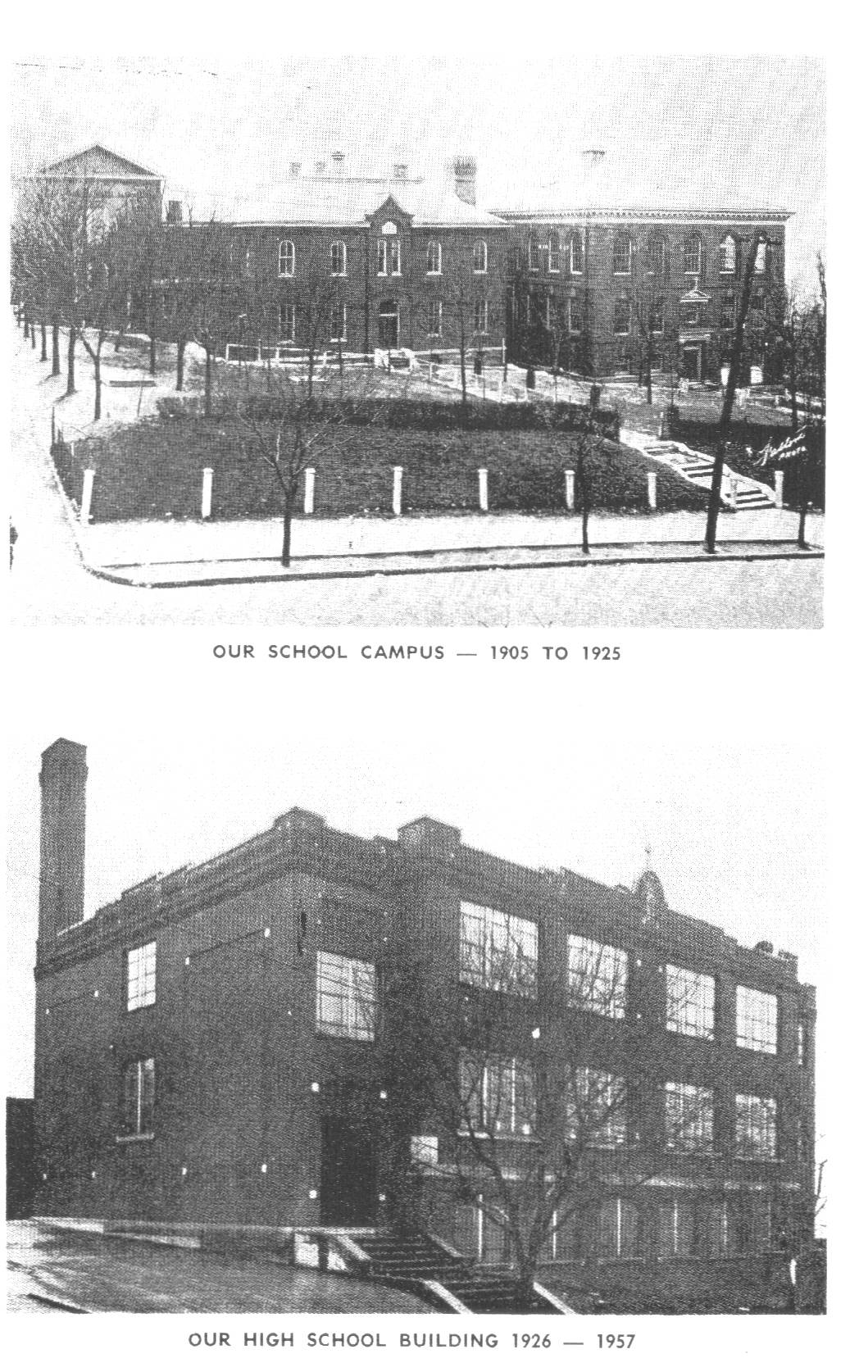

The contract was awarded to Henry Busse, Inc. on a low bid of $352,115.00. Work was started January 30, 1956. It progressed
more or less on schedule and the building was ready as promised for the second half of the 1956-57 school year. Cardinal
Dearden, who was then Bishop of Pittsburgh, dedicated it January 20, 1957.
The new addition gave the High School
eight classrooms, a library, a laboratory, a typing room, a Doctor's Office and a Principal's Office. It also had use of
the Music Room, the Auditorium, the Social Hall and the Gym. The Grade School had twenty-three rooms at its disposal. The
High School enrollment was 320 pupils and a staff of ten Sisters plus two physical education instructors. The Grade School
had an enrollment of one thousand and thirty pupils and a teaching staff of fifteen sisters and five lay teachers.
At this time the parish convent which had stood for additions, because of its size, age, and construction was no longer able
to serve the needs of the Sisters. Moreover, the addition to the High School buildings had taken up the school play area.
A new convent and a play area achieved top priorities.
By 1960 plans began to crystallize. The property on which
the convent stood would be turned into a play area and the new convent would be located on Cathedral Avenue. The parish owned
a plot of ground there 100 feet by 100 feet. To accommodate a convent the size needed, an additional 50 feet would be required.
In September 1961 the parish was able to purchase the Jerry Reis property, which adjoined the parish property and was fifty
feet wide. The parish now had the required ground. The old farmhouse on the parish property and the Reis home were demolished
in 1962 and the site was ready for a convent.
In 1963, architect Mr. Edward Bachmann, because of his previous satisfactory
work for the parish, was hired to prepare the plans. He worked closely with the Sisters and the Church Committee and in June
of 1964 his plans were approved and permission granted to hire as general contractor the firm of F. J. Busse. Work was started
in July 1964, and was carried to completion in August of 1965. Bishop Leonard who was then Auxiliary of Pittsburgh blessed
the Building.
The old convent building was demolished; the ground leveled, covered with asphalt and fenced in.
The school now again had an adequate recreation area and the Sisters had a new, adequate convent.
During the 100
years of its existence, Saint Joseph parish had 12,423 of its infants baptized; 3,250 of its young people married and 5,170
of its members buried.

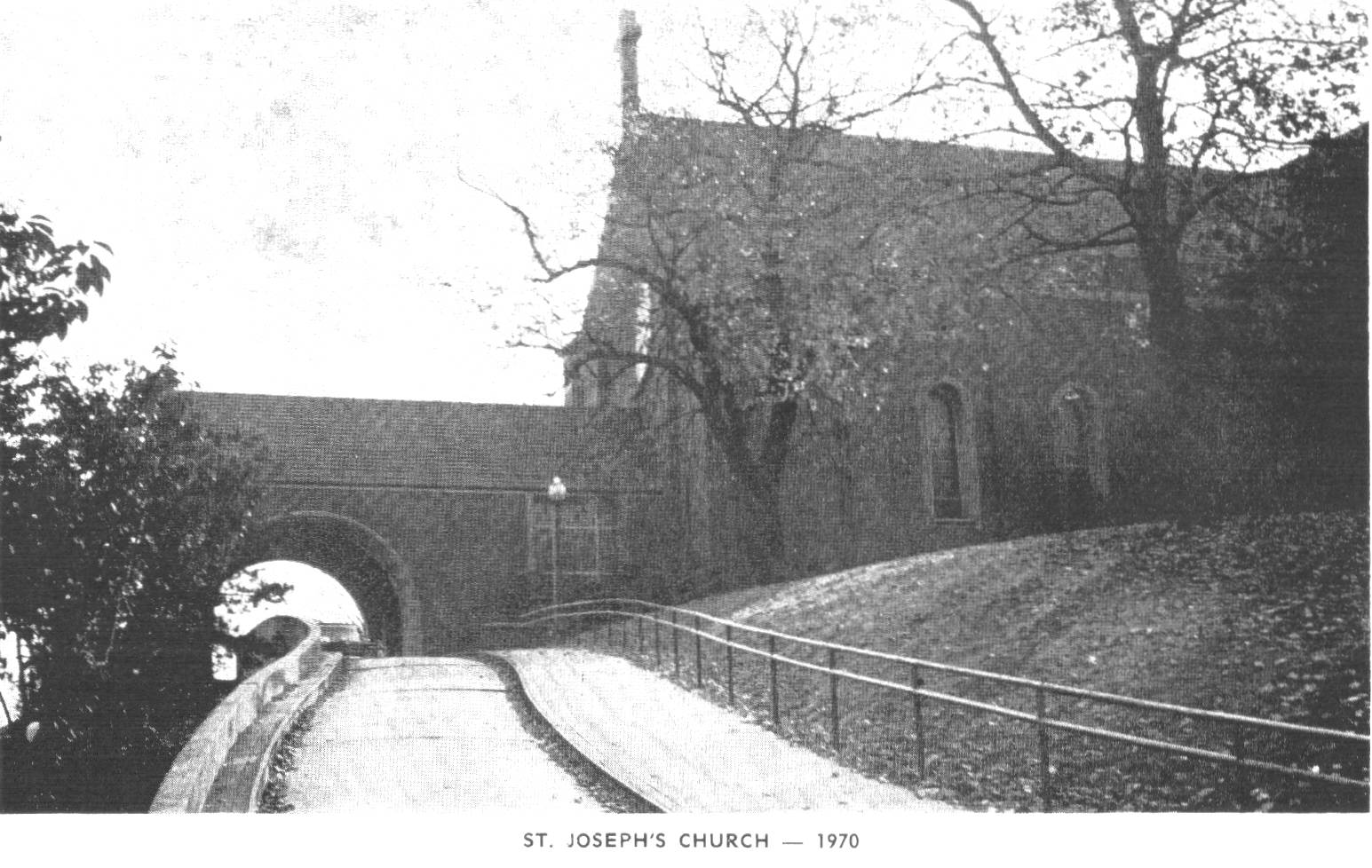
The story of St. Joseph would be far from complete without the names of the priests who labored zealously in the parish as
assistant pastors. They are:
Fr. B. Baldauf.............Fr. Edward Nemmer............Fr. Carl Roemele
Fr. Charles
Duwell.........Fr. M. P. Hinnebusch.........Fr. John Gibson
Fr Anthony Smelsz..........Fr. Alexander Schutte........Fr.
Richard Mueller
Fr. Adolph Keller..........Fr. Walter Schaming..........Fr. Gerard. Klein
Fr. August A. Vogt.........Fr.
Herbert Cost.............Fr. Robert Huber
Fr. Paul M. Brosse.........Fr. Eloy Grundler............Fr. Joseph Miller
Fr.
August Schoppol........Fr. Theodore J. Raab.........Fr. Hohn Ayoob
Fr. Charles Fehrenbach.....Fr. William Scholz...........Fr.
Norbert Campbell
Fr. Hohn S. Feldmeier......Fr. Robert Herrmann
Fr. Matthias Spang.........Fr. Edward Hoffmann
Tribute must be paid also to the Sisters of Saint Francis who labored unstintingly throughout the 100 years of St.
Joseph's existence to teach the children of the parish and to cooperate with the parents of the children in their effort to
mold sterling Christian men and women. The thousands of exemplary Catholic families scattered through the Suburbs to the
South of the parish give eloquent testimony to their success.
The people make the parish. So a final word must
be said for them. From the beginning of its existence the people of St. Joseph's were most ready to give of their time and
labor for the good of the parish. When the original church was building the men, after their day's work on their farm or
in the mines, would come to help dig the trenches for the foundation. Later they dug the clay and molded it into the bricks
for the walls of the building. This spirit continues to this day. It manifested itself in a special way when fire destroyed
the Church. Men worked day and night to turn the gym into a place to worship until the new Church could be built. The women,
too, God bless them, were not to be outdone. Throughout the years, the parish leaned heavily upon their seemingly untiring
services. To this day the parish continues to receive and use the many skills and services of its will and able members.
I realize that these few lines at the end of the story of St. Joseph parish is a small tribute for the great services
rendered the parish by its dedicated men and women. However, they will not feel slighted. They did not work to have their
deeds recorded on earth. They have faith enough to know that they will receive due credit in the annals of the Saints in
heaven.
The following societies have been established and are active in the parish: (They are listed alphabetically lest their listing
would seem to indicate a preference of one over another. As children of the parish family all are important and appreciated.)
The Auditorium Committee....................The Knights of St. George Auxiliary
The Athletic Committee......................The
Ladies of Charity
The Boy Scouts..............................The Loyal Christian Benefit Assoc
The Brownies................................The
Lyceum
The Catholic Youth Organization.............The Men's Choir
The Christian Mothers and ..................The
Mother's Club
Rosary Society.
The Confraternity of Christian..............The Poor Souls Society
Doctrine
The Credit Union............................The Sacred Heart League
The Golden Age Club.........................The
Third Order of St. Francis
The Holy Name Society.......................The Ushers Club
The Knights of St.
George...................The St. Vincent DePaul Society
All these societies though diverse in the means they
employ work in harmony for the benefit of the whole parish. As parts of the parish they receive their strength from it.
They know that they can function properly only if the parish as a whole is healthy and strong. Their contribution to the
general health of the parish is inspiring and valued.
A final word for both the past and present Church Committees.
The members of the Church Committee are the only elected officers of the parish as a whole. In the councils of the parish
they represent the parish members and advise the pastor in the making of decisions for the good of the parish that are not
already determined by Canon Law or Statutes of the Diocese. The fact that at 100 years the parish is strong and healthy speaks
well for their counseling throughout the years. The Church Committee not only advises the pastor but it also keeps an eye
on the parish finances. Its members count the collections and audit the parish account books. Those who served on the Church
Committee in that past and are servicing in the present deserve well of the parish.
The present members of the Church Committee are the following (again in alphabetical order):
Ralph Bachner.......................Charles
J. Kowalski
Kenneth E. Baldauff.................Raymond J. Kuehn
Edward J. Baumgart..................Carl
A. Lauterbach
Jacob J. Breier.....................Stephen T. Rattay
Joseph B. Feth......................William
Speigel
God has blessed St. Hoseph parish in the years gone by. Let us pray and hope and live so that His blessings
will abide with our parish and its members for the centuries to come.
ONE HUNREDTH ANNIVERSARY
CONCELEBRATED MASS
NOVEMBER 29, 1970
MOST REV. VINCENT M. LEONARD
Bishop of Pittsburgh, Chief Celebrant
Rev. Leo A. Kraus, Pastor
Rev. Joseph Miller
Rev. Norbert Campbell
Very Rev. Jerome McKenna,
C.P.
Rev. Aloysius Berk
Rev. Donald Breir
Rev. Theodore Raab
Co-Celebrants

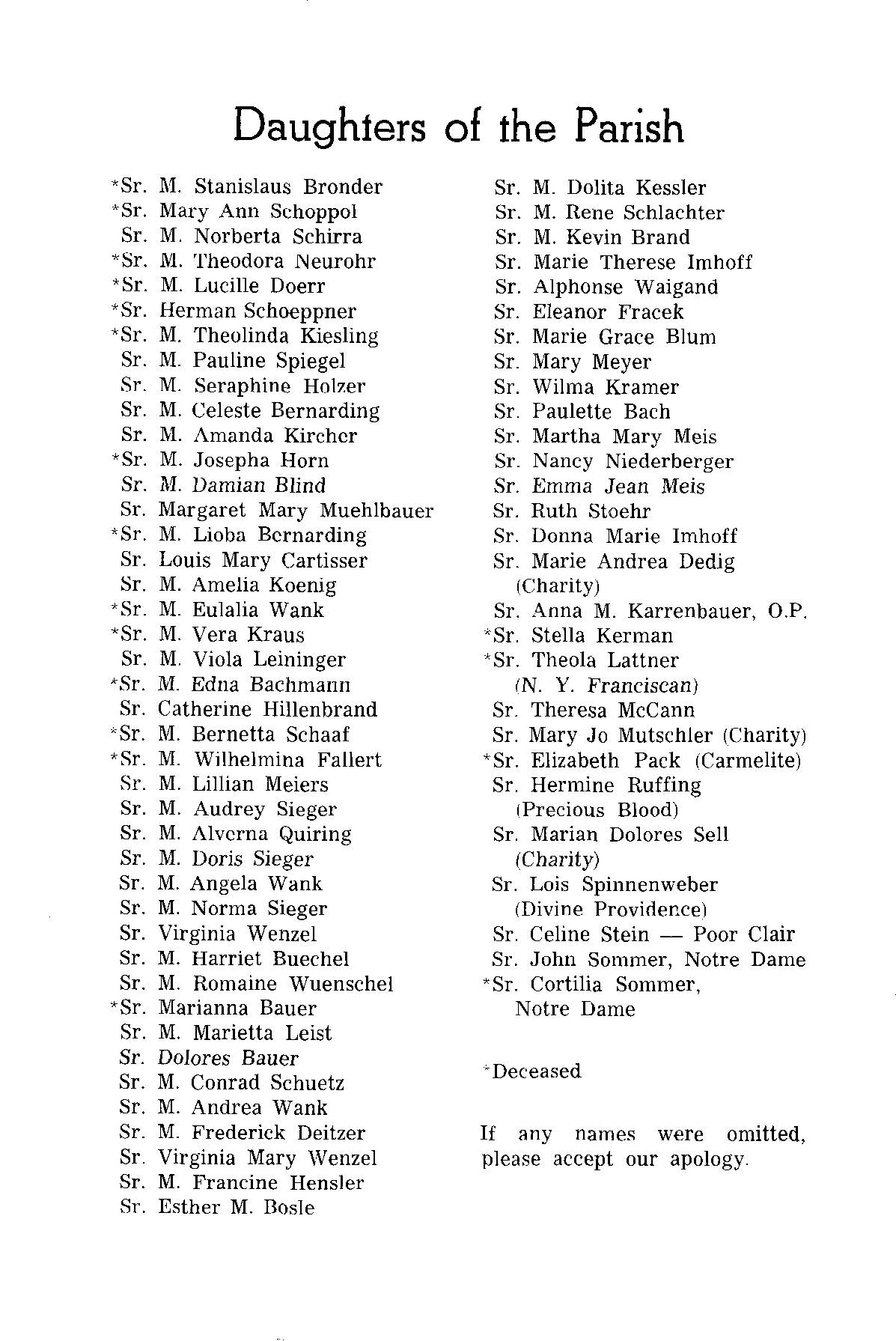
|












